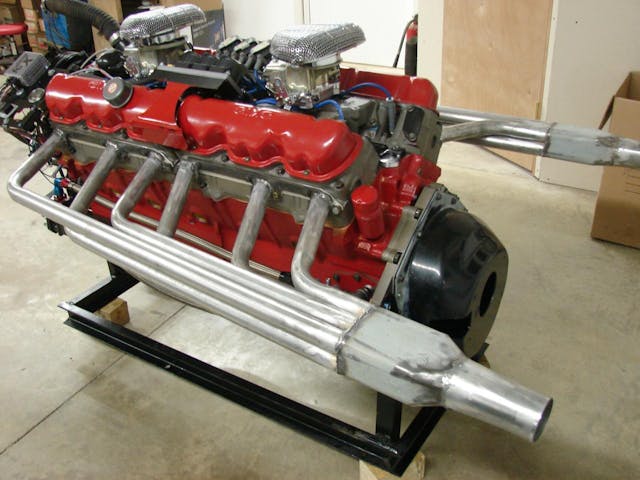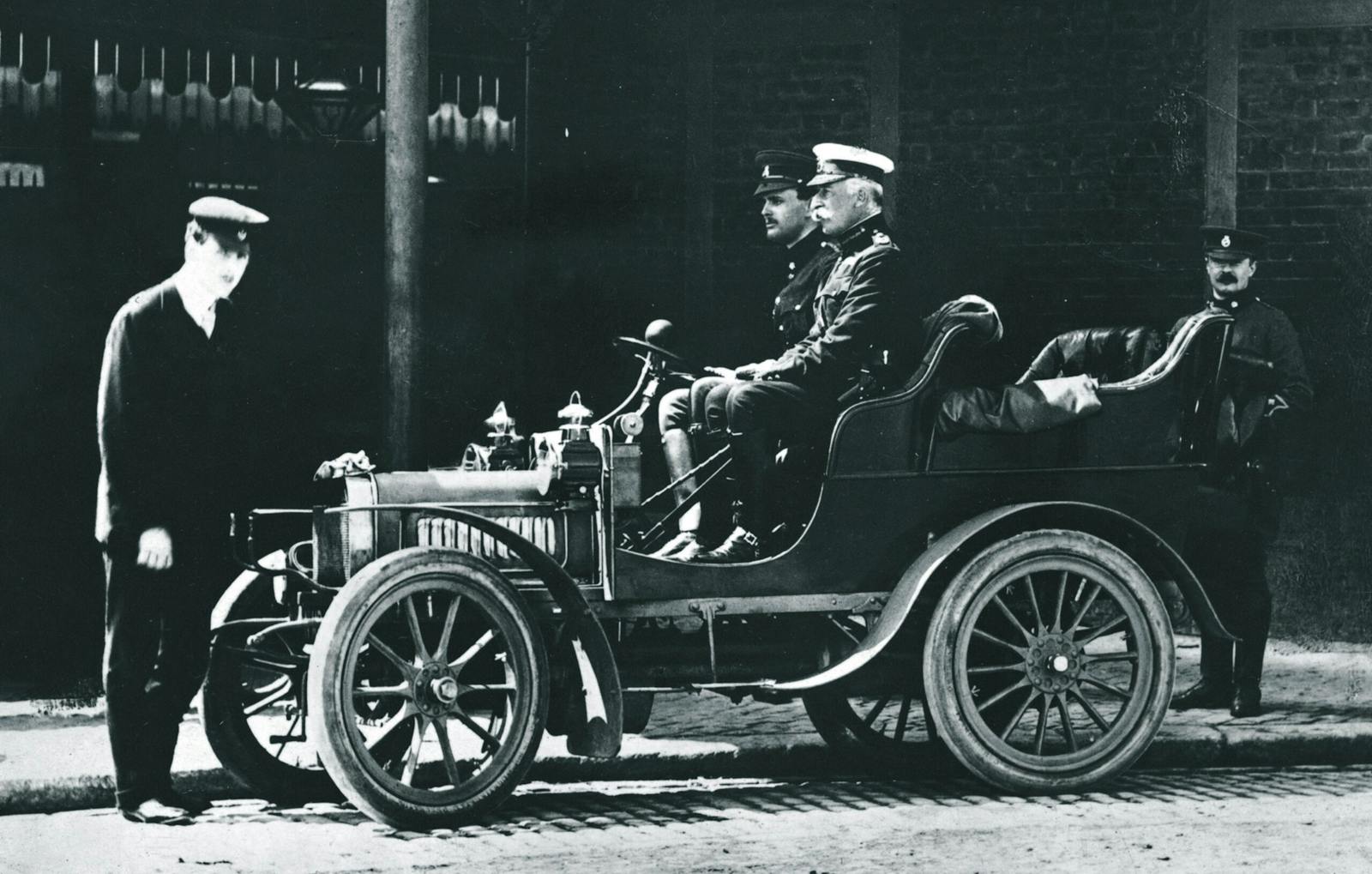The cast-iron madness of GM’s 11.5-liter V-12

Much as the V-8 engine format has been closely associated with American automakers, V-12s are generally regarded as the province of European luxury manufacturers. Consequently, the latter type of engine is widely thought of as sophisticated, at least next to the more plebian bent-eight.
Even when General Motors considered making a V-12 for Cadillac in the 1960s, the 12-cylinder “V Future” engine eschewed conventional Detroit engineering like cast-iron blocks and pushrods for aluminum heads, aluminum blocks, and overhead cams. At the time, however, the General was already making a V-12—a 1485-pound, 702-cubic-inch behemoth called the Twin Six. It came from GM’s GMC truck division.
This leviathan was made for just five years, from 1961 to 1965. It came at a time when gasoline was so cheap that the Twin Six’s three-mile-per-gallon consumption was deemed acceptable by trucking companies. It remains the largest-displacement gasoline production engine produced by a major car company since World War II.

In 1960, GMC unveiled a new family of smooth-running, 60-degree V-6s. These engines, designed for use in heavy-duty trucks, featured a stout six-throw crankshaft, pushrods, and a single cam. They were available in a range of displacements from 305 to 478 cubic inches.
One year later, GMC announced the Twin Six, derived from that line, essentially two 351 V-6s stuck end to end. Total displacement was 702.4 cubes or 11.5 liters. The compression ratio was 7.5:1. The 4.56-inch bore was paired with a 3.58-inch stroke.

Though some think GMC’s V-12 was made by welding or bolting two of those V-6 blocks together, the Twin Six had a dedicated, single-piece, cast-iron crankcase. The forged crank was one piece, four feet long, and 190 pounds. It spun in seven main bearings, with four-bolt main bearing caps, strengthened saddles, and supportive webbing cast into the block.
The Twin Six’s camshaft was also four feet long. It sat relatively high in the block, to allow for shorter pushrods and greater valvetrain stability at (relatively) high rpm. Public confusion as to the block’s construction may be due to the fact that the V-12 used the same cylinder heads as its V-6 siblings, just four instead of two.
By the way, that meant a total of 56 head bolts. Intake and exhaust manifolds were also shared with the six—in all, the two engine families had some 54 parts in common.
The small four-cylinder engine in my car holds about four quarts of oil. The Twin Six’s sump held four gallons. To keep things cool, it had a water pump capable of delivering a remarkable 118 gallons per minute. To keep things lubricated, the engine’s high-output oil pump flowed 17 gallons per minute. Two large downdraft carburetors parked in the vee provided fuel and air.

GMC rated the engine for 275 hp at 2400 rpm (SAE) and 630 lb-ft of torque. The latter figure arrived just off idle, at only 1600 rpm. The Twin Six was marketed to fleet operators based on ease of maintenance—the engine, GMC boasted, could remain in service for at least 15,000 miles with only minor maintenance. On top of that, it was claimed to be good for 200,000 miles without a major overhaul.
Predictably, when this substantial piece of work was discontinued, its successor wore fewer cylinders. When the Twin Six was removed from GMC’s lineup for 1967, the replacement was a 60-degree, 637-cubic-inch V-8 with the same bore and stroke. That engine was cheaper to produce, cheaper to sell, and easier to package.

The big V-12 was also marketed to fire departments, installed in GMC 7000-series fire trucks, and popular with American fire-truck manufacturers. The engine layout was not uncommon in that field. When Lycoming decided to concentrate on aircraft engines, American LaFrance (ALF) bought the rights and the tooling for that company’s overhead-cam V-12 and kept it in production for decades. Seagrave used a modified Pierce-Arrow V-12 with twin distributors and two spark plugs per cylinder.
Not all Twin Sixes ended up in over-the-road trucks—some farmers pressed them into service driving irrigation pumps, impressed with the V-12’s ability to reliably endure harsh conditions. In some stationary applications, the Twin Six has been known to last the equivalent of nearly 23 years of continuous running time. It’s rumored that some are still in use in the American Southwest.
As for today, some custom-car folks see the Twin Six as a less-common alternative to the GM LS or Ford Coyote V-8s. Notable Twin Six projects include the Blastolene B702 built by Michael Leed and Randy Grubb, Pat McNeal’s mid-engine 1942 GMC COE rat rod, and Robert Wunderlin’s stretched 1964 GMC pickup.
Here are some other Twin Six–powered customs.
For those who want something yet even more special, engine builder Bob Walker makes a high-performance iteration of the Twin Six that he calls the Thunder V12. The Evansville, Indiana, engine builder claims his version of the engine “makes the most power between 2000 and 3000 rpm of any automotive-based, naturally aspirated, 87-octane-fueled crate engine you can buy for under $35,000.” Walker’s firm sells parts for the engine as well as bellhousings to mate it to popular automotive transmissions. He is not currently taking rebuild orders, but when the company does have engines available, a turn-key stock rebuild costs $18,590. The “Thunder” version is $24,900.
Around 5000 Twin Sixes are believed to have been built. Thunder V12’s website claims only about 200 still exist, and that most are now “basket cases.” Walker says he spent a year and a half tracking down about 100 of those 200, tearing them down and inspecting and grading their blocks. Only a few make the cut for his treatment.
Thunder V12 rates the performance version of its engines at 425 hp at 4200 rpm and 630 lb-ft of torque at 1800 rpm. A video on the site shows an engine briefly hitting its hard redline of 5000 rpm and staying in one piece. (Walker doesn’t recommend going higher than 4000 normally.) That horsepower rating can be doubled, Thunder V12 says, with predictable performance mods—porting and polishing the head, a roller cam, and better pistons.
As for torque? Thunder V12 says more is available through paths like nitrous oxide or supercharging: The engine is apparently stout enough to take the strain. “An excess of 1200 lb-ft of torque at 2500 rpm would surely satisfy even the most jaded power junkie,” the site says.

Because these engines often have a history of severe-duty use, because remaining examples are often in poor condition, and because parts are often difficult to source, Bob Walker cautions against trying to rebuild one yourself. If you are so inclined, however, at press time, eBay holds a Twin Six in “for parts, not working” condition. It is priced at $3500.
Not surprisingly, it’s local pickup only. And your pickup better be at least a three-quarter-ton.
***
Check out the Hagerty Media homepage so you don’t miss a single story, or better yet, bookmark it. To get our best stories delivered right to your inbox, subscribe to our newsletters.


We had a GMC V6 2-stroke diesel when I was a kid, pretty cool engine, but dirty in non-turbo apps. Most don’t know the positive displacement supercharger was because it didn’t run without the positive air flow, the later Turbo models actually had boost.
Yes, you’re right, BMD4800. As I was once corrected by a Detroit Diesel engineer, the positive displacement device was referred to as a blower, since its job in the 2-stroke Diesel was to fully evacuate the cylinders of exhaust gasses before the next intake stroke. As used in dragsters with 4-stroke gasoline engines, it was adapted for use as a supercharger.
A monster, to be sure. But not the first time two V6s were joined together. After Ford bought Aston Martin in 1987 they decided to build a V-12 for the DB7 that was basically two Ford V-6 truck engines mated end-to-end. Cosworth built the 6 liter engine that arrived in 1999 and it was a resounding success.
The “modular” concepts has been around a long time. GM has been doing it at least since 1939. First with the GM (Detroit) and EMD diesels, then with gasoline engines starting with GMC in 1960, Buick in 1962, Chevy in 1978, Oldsmobile in 1982. Cadillac in the late 90’s and more recently the Atlas in 20002. Even the LS Chevy small block V8 has a modular V6.
The Aston Martin you mentioned was at least 30 years late to the party.
Historical note , this engine powered the tractor of the USAF Minteman missile transporter/erector made by GMC. Still in use today
I have the 478ci gas engine in a ’65 gmc
It is underpowered and inefficient
The diesel based on the same block was viewed as underpowered, inefficient and prone to failure
Haven’t met anyone that had a good thing to say about either one
Maybe you better find someone who knows what they are doing to work on your 478. Mine is powerful and as efficient as any other gasoline engine in a dump truck.
All naturally aspirated diesels are under powered, no matter who makes it. The Toro Flow was no different. None of them will make the same horsepower or torque of an equivalent displacement gasoline engine.
So, have you ever had a 366 big block? Same-same.
Is that V-6 aluminum mentioned the one used in the Buick Skylark (with angst) and then palmed off on Rover?
The GMC V6 was cast iron. The Buick 215 V8 was aluminum and Rover acquired it in the mid 60’s. The V6 based of the 215 was cast iron and introduced for the ’62 model year.
Ray, the first Buick odd-fire V6 was a great little engine and a junkyard one was used as an engineering mule for the later roll out of the 3.8 during the gas crisis.
The Buick 215, aka Rover V8, also lead to the development is the larger 300, 340, and 350 Buick V8s, which were very good engine designs, also sharing tech with the 3.8. These engines weren’t pawned off, the Rover V8 was a main stay for decades until a modern BMW V8 replaced it.
Those little Buick 6s and V8s were phenomenally efficient and clean engines. GM corporate engines killed the Buick V8 in 1980, the V6 lasted into the 2000s. Hardly a “pawned off” design.
Worked on several of these. Two 2V Stromberg WWC carburetors. Huge compound Delco distributor with a tin cover over the breaker points & dual 6 cyl distributor caps. Single block, Crank, & Cam, 4 cylinder heads with 2 intake manifolds.
I owned a 1962 351 V-6 mated to a Dual Range Hydro it passed everything slowly, but it never passed a gas station
When I drew the short straw and had to change the oil/filter on our 1965 Van Pelt 1250 Gpm pumper with a 817 cu in 6 Cyl twin carb Wakashaw gas engine. The fun was changing 26 quarts of oil plus filter.. it’s still running as a parade vehicle in Fair Oaks, CA. Sacramento Metro Fire Dept.
Fascinating! Never knew these existed.